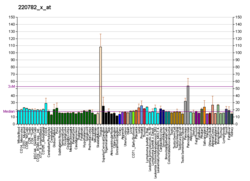KLK12
Protein-coding gene in the species Homo sapiens
| KLK12 | |||||||||||||||||||||||||||||||||||||||||||||||||||
|---|---|---|---|---|---|---|---|---|---|---|---|---|---|---|---|---|---|---|---|---|---|---|---|---|---|---|---|---|---|---|---|---|---|---|---|---|---|---|---|---|---|---|---|---|---|---|---|---|---|---|---|
| Identifiers | |||||||||||||||||||||||||||||||||||||||||||||||||||
| Aliases | KLK12, KLK-L5, KLKL5, kallikrein related peptidase 12 | ||||||||||||||||||||||||||||||||||||||||||||||||||
| External IDs | OMIM: 605539; MGI: 1916761; HomoloGene: 44690; GeneCards: KLK12; OMA:KLK12 - orthologs | ||||||||||||||||||||||||||||||||||||||||||||||||||
| |||||||||||||||||||||||||||||||||||||||||||||||||||
| |||||||||||||||||||||||||||||||||||||||||||||||||||
| |||||||||||||||||||||||||||||||||||||||||||||||||||
| |||||||||||||||||||||||||||||||||||||||||||||||||||
| |||||||||||||||||||||||||||||||||||||||||||||||||||
| Wikidata | |||||||||||||||||||||||||||||||||||||||||||||||||||
| |||||||||||||||||||||||||||||||||||||||||||||||||||
Kallikrein-12 is a protein that in humans is encoded by the KLK12 gene.[5][6][7]
Kallikreins are a subgroup of serine proteases having diverse physiological functions. Growing evidence suggests that many kallikreins are implicated in carcinogenesis and some have potential as novel cancer and other disease biomarkers. This gene is one of the fifteen kallikrein subfamily members located in a cluster on chromosome 19. Alternate splicing of this gene results in three transcript variants encoding different isoforms.[7]
References
- ^ a b c GRCh38: Ensembl release 89: ENSG00000186474 – Ensembl, May 2017
- ^ a b c GRCm38: Ensembl release 89: ENSMUSG00000044430 – Ensembl, May 2017
- ^ "Human PubMed Reference:". National Center for Biotechnology Information, U.S. National Library of Medicine.
- ^ "Mouse PubMed Reference:". National Center for Biotechnology Information, U.S. National Library of Medicine.
- ^ Lundwall A, Band V, Blaber M, Clements JA, Courty Y, Diamandis EP, Fritz H, Lilja H, Malm J, Maltais LJ, Olsson AY, Petraki C, Scorilas A, Sotiropoulou G, Stenman UH, Stephan C, Talieri M, Yousef GM (Jun 2006). "A comprehensive nomenclature for serine proteases with homology to tissue kallikreins". Biol Chem. 387 (6): 637–41. doi:10.1515/BC.2006.082. PMID 16800724. S2CID 436200.
- ^ Diamandis, Eleftherios P.; Deperthes, David; Lundwall, Åke (Jun 2006). "Proceedings of the 1st International Symposium on Kallikreins, Lausanne, Switzerland, September 1-3 , 2005". Biol Chem. 387 (6): 635–824. doi:10.1515/BC.2006.081. PMID 16800723. S2CID 83910246.
- ^ a b "Entrez Gene: KLK12 kallikrein-related peptidase 12".
Further reading
- Diamandis EP, Yousef GM, Luo LY, et al. (2001). "The new human kallikrein gene family: implications in carcinogenesis". Trends Endocrinol. Metab. 11 (2): 54–60. doi:10.1016/S1043-2760(99)00225-8. PMID 10675891. S2CID 25806934.
- Yousef GM, Luo LY, Diamandis EP (2000). "Identification of novel human kallikrein-like genes on chromosome 19q13.3-q13.4". Anticancer Res. 19 (4B): 2843–52. PMID 10652563.
- Harvey TJ, Hooper JD, Myers SA, et al. (2001). "Tissue-specific expression patterns and fine mapping of the human kallikrein (KLK) locus on proximal 19q13.4". J. Biol. Chem. 275 (48): 37397–406. doi:10.1074/jbc.M004525200. PMID 10969073.
- Yousef GM, Chang A, Scorilas A, Diamandis EP (2000). "Genomic organization of the human kallikrein gene family on chromosome 19q13.3-q13.4". Biochem. Biophys. Res. Commun. 276 (1): 125–33. doi:10.1006/bbrc.2000.3448. PMID 11006094.
- Gan L, Lee I, Smith R, et al. (2001). "Sequencing and expression analysis of the serine protease gene cluster located in chromosome 19q13 region". Gene. 257 (1): 119–30. doi:10.1016/S0378-1119(00)00382-6. PMID 11054574.
- Yousef GM, Magklara A, Diamandis EP (2001). "KLK12 is a novel serine protease and a new member of the human kallikrein gene family-differential expression in breast cancer". Genomics. 69 (3): 331–41. doi:10.1006/geno.2000.6346. PMID 11056051.
- Strausberg RL, Feingold EA, Grouse LH, et al. (2003). "Generation and initial analysis of more than 15,000 full-length human and mouse cDNA sequences". Proc. Natl. Acad. Sci. U.S.A. 99 (26): 16899–903. Bibcode:2002PNAS...9916899M. doi:10.1073/pnas.242603899. PMC 139241. PMID 12477932.
- Clark HF, Gurney AL, Abaya E, et al. (2003). "The secreted protein discovery initiative (SPDI), a large-scale effort to identify novel human secreted and transmembrane proteins: a bioinformatics assessment". Genome Res. 13 (10): 2265–70. doi:10.1101/gr.1293003. PMC 403697. PMID 12975309.
- Grimwood J, Gordon LA, Olsen A, et al. (2004). "The DNA sequence and biology of human chromosome 19". Nature. 428 (6982): 529–35. Bibcode:2004Natur.428..529G. doi:10.1038/nature02399. PMID 15057824.
- Shinmura K, Tao H, Yamada H, et al. (2005). "Splice-site genetic polymorphism of the human kallikrein 12 (KLK12) gene correlates with no substantial expression of KLK12 protein having serine protease activity". Hum. Mutat. 24 (3): 273–4. doi:10.1002/humu.9270. PMID 15300858. S2CID 39475520.
- Memari N, Jiang W, Diamandis EP, Luo LY (2007). "Enzymatic properties of human kallikrein-related peptidase 12 (KLK12)". Biol. Chem. 388 (4): 427–35. doi:10.1515/BC.2007.049. PMID 17391064. S2CID 25034775.
External links
- The MEROPS online database for peptidases and their inhibitors: S01.020
- v
- t
- e


















